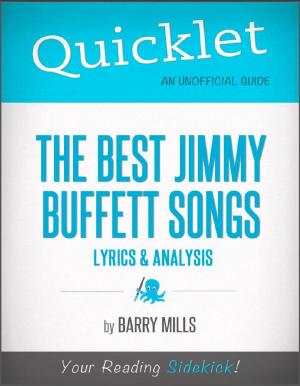Quicklet on Charles Duhigg's The Power of Habit: Why We Do What We Do in Life and Business: Detailed Summary & Analysis
Fiction & Literature, Literary Theory & Criticism, Nonfiction, Health & Well Being, Self Help, Self Improvement, Business & Finance| Author: | Karen Watkins | ISBN: | 9781614646228 |
| Publisher: | Hyperink | Publication: | July 30, 2012 |
| Imprint: | Hyperink - The Power of Habit Quicklet | Language: | English |
| Author: | Karen Watkins |
| ISBN: | 9781614646228 |
| Publisher: | Hyperink |
| Publication: | July 30, 2012 |
| Imprint: | Hyperink - The Power of Habit Quicklet |
| Language: | English |
ABOUT THE BOOK
Charles Duhigg was a reporter in Iraq a decade ago when he heard about an army major who was analyzing videotapes of riots. He wanted to see if he could detect any patterns that might help him stop the riots before they began. He did.
First, a small crowd would gather in a plaza. Within a few hours, they would begin to chant angry slogans. Spectators would show up. Food vendors would arrive. Time would pass. The chanting would get louder. More time would pass. The spectators would remain in a relatively small space, except around dusk when they got hungry. They’d buy some food, then return to their original spot.
That was the pattern for most, but there were some who would march into the middle of the crowd, back out to the edge, back to the middle. Those were the troublemakers. One would throw a bottle, another would throw a rock. Within 15 minutes, there would be a full-scale riot.
The major told Duhigg that after observing this pattern, he scheduled a meeting with the town’s mayor. He made what must have seemed like an odd request. Would it be possible for the police to keep food vendors out of the plazas?
The mayor said yes.
A few weeks later, a small crowd gathered near a plaza. As the afternoon wore on, they began chanting angry slogans. Spectators showed up. Time passed. The chanting got louder. More time passed. Dusk fell. But this time, there were no food vendors to feed the crowd. Some went home to eat. Some went to restaurants. By 8PM, nearly everyone was gone. The riot never happened.
Duhigg asked the major what made him realize that something as simple as getting rid of the food vendors would end the riots.
The major said that the U.S. military had taught all about habits--how they’re formed, how they’re broken. The U.S. military, he said, was “one of the biggest habit-formation experiments in history” and that understanding habits was “the most important thing” he’d learned in the army.
Duhigg became intrigued by habits and their power.
“That’s what this book is about,” he writes. “Changing habits isn’t necessarily quick or easy. But it is possible. And now we know how.”
EXCERPT FROM THE BOOK
How do you sell a record that people hate?
That was the problem for Steve Bartels, promotion executive at Arista Records. The song was “Hey Ya!” by OutKast. He thought it would be a sure hit. He convinced radio stations to play it, but listeners hated it so much, they turned the dial.
The problem was “Hey Ya!” didn’t sound like other songs. People want to listen to their favorite songs or songs that sound like their favorite songs. But Bartels wasn’t ready to give up.
III.
During World War II, meat was scarce, but organ meat was plentiful. The problem was getting housewives to serve it. They weren’t familiar with it. The solution was to make it seem familiar by “camouflaging it in everyday garb.”
The government sent out mailers telling women their husbands would “cheer for steak and kidney pie” which would contain a little steak and a lot of kidney. Butchers gave out recipes for meatloaf made with liver. Organ consumption rose by 33% during the war.
IV.
Arista decided the secret to making “Hey Ya!” a hit was to make it familiar. To do that, they sandwiched it between “sticky” songs, songs that keep the listener listening. Some songs are sticky because people like them. Some are sticky even though people hate them. Men say they hate Celine Dion, but they don’t switch the station when her songs come on.
It worked. People got used to “Hey Ya!” Then they started to crave it. It sold more than 5.5 million records and won a Grammy.
ABOUT THE BOOK
Charles Duhigg was a reporter in Iraq a decade ago when he heard about an army major who was analyzing videotapes of riots. He wanted to see if he could detect any patterns that might help him stop the riots before they began. He did.
First, a small crowd would gather in a plaza. Within a few hours, they would begin to chant angry slogans. Spectators would show up. Food vendors would arrive. Time would pass. The chanting would get louder. More time would pass. The spectators would remain in a relatively small space, except around dusk when they got hungry. They’d buy some food, then return to their original spot.
That was the pattern for most, but there were some who would march into the middle of the crowd, back out to the edge, back to the middle. Those were the troublemakers. One would throw a bottle, another would throw a rock. Within 15 minutes, there would be a full-scale riot.
The major told Duhigg that after observing this pattern, he scheduled a meeting with the town’s mayor. He made what must have seemed like an odd request. Would it be possible for the police to keep food vendors out of the plazas?
The mayor said yes.
A few weeks later, a small crowd gathered near a plaza. As the afternoon wore on, they began chanting angry slogans. Spectators showed up. Time passed. The chanting got louder. More time passed. Dusk fell. But this time, there were no food vendors to feed the crowd. Some went home to eat. Some went to restaurants. By 8PM, nearly everyone was gone. The riot never happened.
Duhigg asked the major what made him realize that something as simple as getting rid of the food vendors would end the riots.
The major said that the U.S. military had taught all about habits--how they’re formed, how they’re broken. The U.S. military, he said, was “one of the biggest habit-formation experiments in history” and that understanding habits was “the most important thing” he’d learned in the army.
Duhigg became intrigued by habits and their power.
“That’s what this book is about,” he writes. “Changing habits isn’t necessarily quick or easy. But it is possible. And now we know how.”
EXCERPT FROM THE BOOK
How do you sell a record that people hate?
That was the problem for Steve Bartels, promotion executive at Arista Records. The song was “Hey Ya!” by OutKast. He thought it would be a sure hit. He convinced radio stations to play it, but listeners hated it so much, they turned the dial.
The problem was “Hey Ya!” didn’t sound like other songs. People want to listen to their favorite songs or songs that sound like their favorite songs. But Bartels wasn’t ready to give up.
III.
During World War II, meat was scarce, but organ meat was plentiful. The problem was getting housewives to serve it. They weren’t familiar with it. The solution was to make it seem familiar by “camouflaging it in everyday garb.”
The government sent out mailers telling women their husbands would “cheer for steak and kidney pie” which would contain a little steak and a lot of kidney. Butchers gave out recipes for meatloaf made with liver. Organ consumption rose by 33% during the war.
IV.
Arista decided the secret to making “Hey Ya!” a hit was to make it familiar. To do that, they sandwiched it between “sticky” songs, songs that keep the listener listening. Some songs are sticky because people like them. Some are sticky even though people hate them. Men say they hate Celine Dion, but they don’t switch the station when her songs come on.
It worked. People got used to “Hey Ya!” Then they started to crave it. It sold more than 5.5 million records and won a Grammy.















